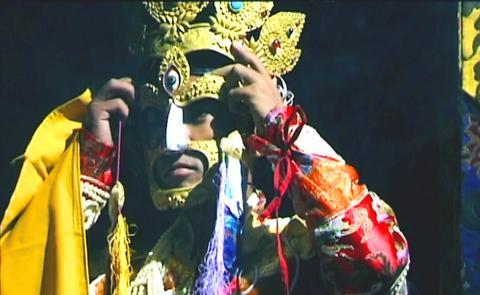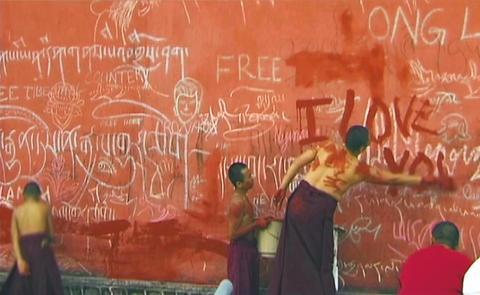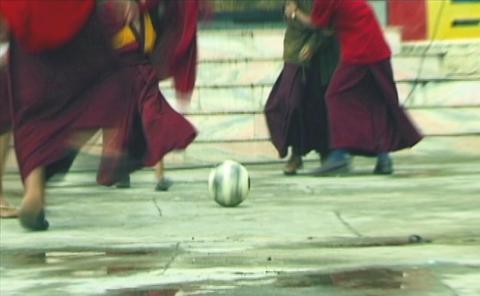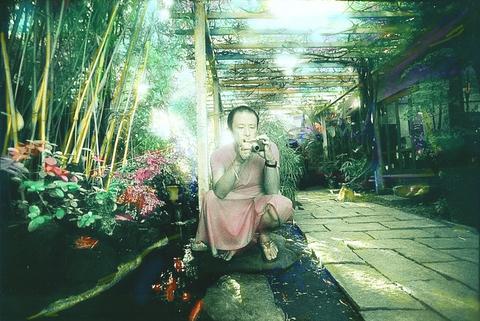Why does one go to the cinema? For some, it is to escape the reality of life. For Anika Tokarchuk, cinema is the reality of her life. For the past six years, her existence has revolved around the shifting images, sounds, and characters on the screen. Recently, the Canadian filmmaker who is now living in Taipei debuted her documentary, Life as Cinema, on Public Television Service (PTS,
What started off in 1998 as a documentary on the making of The Cup by Dzongsar Khyentse Rinpoche led Tokarchuk on a journey from Canada through Europe, India and finally to Taiwan. Her project has turned into a three-part series, drawing on support from respected members of the Taiwanese film industry and various buddhist organizations.
"This documentary started off as Rinpoche's idea," Tokarchuk said. "Of course, I really was excited about it, but I had no idea how incredible and how wild the adventure would be. I've lived through this whole amazing experience while making this film, and by doing so I think it has molded the character of the film."

PHOTO COURTESY OF ANIKA TOKARCHUK,IMAGE LANTERN PICTURES LTD
At first, the road was smooth. With a conditional approval for funding through the Canadian film and television industry, Tokarchuk left to begin shooting in India. Six months later, however, on the same day she received permission to interview the Dalai Lama, the offer for funding was unexpectedly withdrawn. Having explored all avenues for financial support before leaving Canada, Tokarchuk felt returning was not an option. To make things worse, she had only US$200 remaining and no return flight.
"It really felt like a dead end to go back. And plus I had my film 80 percent made, it's kind of like if you are seven months pregnant you can't have an abortion, you have to go through with it," she said.
Contemplating her next move, Tokarchuk remained in Dharamshala, where she met a number of individuals teaching English in north-east Asia. Taiwan, a prosperous English teaching market and a country with a growing relationship with Tibet -- both in funding and number of dharma students -- seemed to offer the best environment for Anika's film.

PHOTO COURTESY OF ANIKA TOKARCHUK,IMAGE LANTERN PICTURES LTD
A coincidental meeting with the well-known Taiwanese director, Stan Lai (
Two years went by and Tokarchuk took up residence in Taiwan as an English teacher. After earning enough money to furbish her own home film studio, she was ready to begin the arduous job of editing. An increasingly visible future slowly emerged through a web of connections, one of which is Hung Hung (
Associate director of Life as Cinema, Hung encouraged

PHOTO COURTESY OF ANIKA TOKARCHUK,IMAGE LANTERN PICTURES LTD
Tokarchuk to "go wild" with the 200-hours of footage. "It is much more than a film to her," said Hung, "It is a journey of discovery and the Buddhist dharma that she was practicing through the making of this film. She needed to continue, to finish the project."
Hung said that, to some people, the film might be too experimental in its approach. "Some films need to be seen twice to be understood," he said, implying it's not easy to digest a real meal after being fed junk food for so long.
Sylvia Feng (

PHOTO COURTESY OF ANIKA TOKARCHUK,IMAGE LANTERN PICTURES LTD
One scene in the documentary covers a discussion held at the famed Wisteria Tea House in Taipei. Feng said, "No Taiwanese photographer could capture the aura of Wisteria Tea House [a popular meeting place for"intellectuals'] better than Anika [Tokarchuk] ... her visualization of the intellectual culture in Taipei may spark enlightenment for Taiwanese directors."
The appreciation of Tokarchuk's film, however, goes beyond just artistic or intellectual circles. The Hao Ran Foundation (
Another supporter, Su-Jei Own (

PHOTO COURTESY OF ANIKA TOKARCHUK, IMAGE LANTERN PICTURES LTD
Tokarchuk's experience of making the film changed her perceptions, as she thought they would. "The experience that I've gone through has been my version of living through the themes in Life as Cinema. It really has been this experience of living in this amazing reality."

Most heroes are remembered for the battles they fought. Taiwan’s Black Bat Squadron is remembered for flying into Chinese airspace 838 times between 1953 and 1967, and for the 148 men whose sacrifice bought the intelligence that kept Taiwan secure. Two-thirds of the squadron died carrying out missions most people wouldn’t learn about for another 40 years. The squadron lost 15 aircraft and 148 crew members over those 14 years, making it the deadliest unit in Taiwan’s military history by casualty rate. They flew at night, often at low altitudes, straight into some of the most heavily defended airspace in Asia.

Beijing’s ironic, abusive tantrums aimed at Japan since Japanese Prime Minister Sanae Takaichi publicly stated that a Taiwan contingency would be an existential crisis for Japan, have revealed for all the world to see that the People’s Republic of China (PRC) lusts after Okinawa. We all owe Takaichi a debt of thanks for getting the PRC to make that public. The PRC and its netizens, taking their cue from the Chinese Communist Party (CCP), are presenting Okinawa by mirroring the claims about Taiwan. Official PRC propaganda organs began to wax lyrical about Okinawa’s “unsettled status” beginning last month. A Global

Taiwan’s democracy is at risk. Be very alarmed. This is not a drill. The current constitutional crisis progressed slowly, then suddenly. Political tensions, partisan hostility and emotions are all running high right when cool heads and calm negotiation are most needed. Oxford defines brinkmanship as: “The art or practice of pursuing a dangerous policy to the limits of safety before stopping, especially in politics.” It says the term comes from a quote from a 1956 Cold War interview with then-American Secretary of State John Foster Dulles, when he said: ‘The ability to get to the verge without getting into the war is

Like much in the world today, theater has experienced major disruptions over the six years since COVID-19. The pandemic, the war in Ukraine and social media have created a new normal of geopolitical and information uncertainty, and the performing arts are not immune to these effects. “Ten years ago people wanted to come to the theater to engage with important issues, but now the Internet allows them to engage with those issues powerfully and immediately,” said Faith Tan, programming director of the Esplanade in Singapore, speaking last week in Japan. “One reaction to unpredictability has been a renewed emphasis on